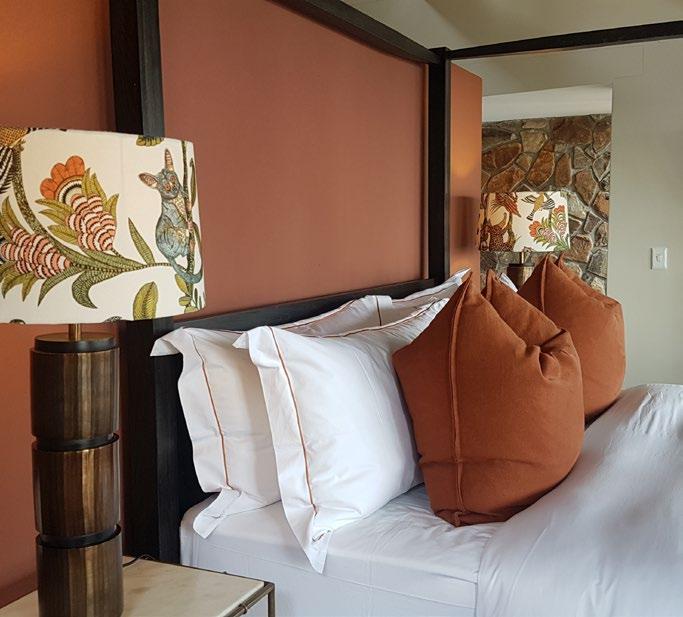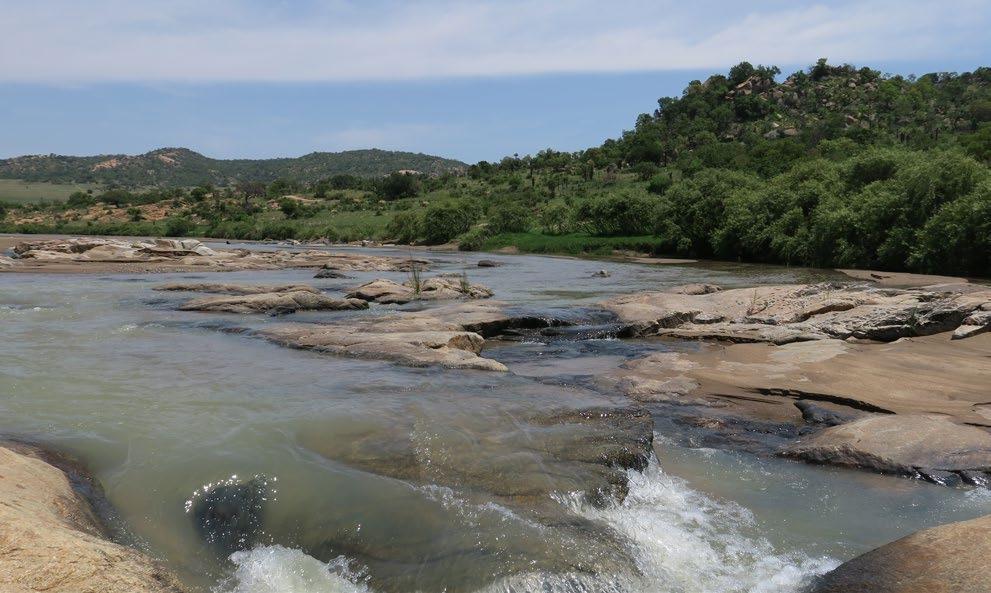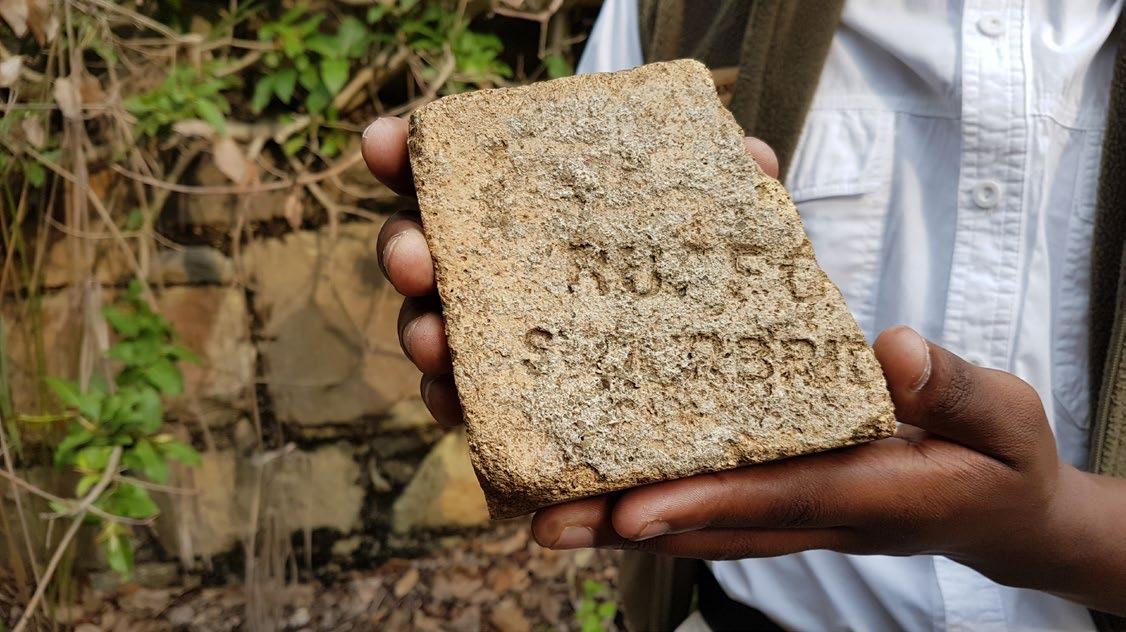
10 minute read
success story in the making
Achorus of birds proclaims the morning. The repetitive call of the red-chested cuckoo (aka Piet My Vrou) easily outdoing the melodious ‘pretty Georgie’ of the African emerald cuckoo and the mournful cry of the black cuckoo. The sun-dappled hillsides of the evening before were shrouded in mist. All evidence of the rocky koppies and swathes of aloes from our game drive the day before temporarily cloaked.

Advertisement
I was at Zulu Rock Lodge in the Babanango Game Reserve (BGR), located in the heart of South Africa’s beautiful northern KwaZuluNatal (KZN). Its mountainside location ensured sweeping views across a dramatic wilderness, the grasslands and savanna punctuated with rocky outcrops and the White Umfolozi river in the distance. My stone-clad chalet was beautifully decorated in a minimalistic yet comfortable way, the earthy tones blending perfectly with the expansive views beyond the bi-fold doors leading onto my private deck. There was even a fireplace which would be perfect for chilly winter evenings armed with a good book and a glass of red wine.

The décor in the main lodge area gives one a sense of place with several curated Zulu artifacts and a selection of wildlife photographs on canvas. This is the social hub of the lodge, it’s where conversations and laughter fill the air, where one lingers over a meal and where glorious sunsets are celebrated. It’s the place to relax on a couch with a cappuccino or grab the binoculars and scan the hillsides below for game – where anything from wildebeest and zebra to giraffe and white rhino may come into view. One thing is certain though, Zulu Rock Lodge is all about the views!

Our afternoon game drive with guide Theo and Babanango Reserve Manager Musa Mbatha had us ‘oohing and aahing’ over the views, we gaze up in amazement at the height of the aloes and listen to tales of the region’s history – these were once the stomping ground of Zulu kings and warriors alike.
We watch hippos in the dam and are rewarded by what appears to be a yawn, but we learn that it is in fact a warning sign that it is feeling threatened… so we move on. A stately blue crane, South Africa’s national bird, feeds from the grassland, and as we watch Musa tells us that they are breeding on the reserve which is great news as their conservation status is classified as vulnerable. He tells us that the secretary bird, also classified as vulnerable, are breeding too. We chuckle at a confused male giraffe as he fails to get the action that he clearly desires and his mate wanders off, perhaps in frustration.
A pair of white rhino graze alongside us, oblivious to their threatened status and unaware of the security team that oversees their safety. They don’t seem to notice us, more concerned with filling their bellies with the lush greenery the spring rains have brought.

Many reserves frown upon any mention of their rhino, but not here where Jeff van Staden, COO of African Habitat Conservancy (AHC), tells us that they are extremely proud of their small but growing rhino population and the conservation success that their security team ensures.
That evening I raise a toast to their continued success, my G&T aglow as flames flicker on the deck and the sun sinks below the horizon – I sigh in contentment, all is well in this special piece of Africa…






Jeff is our driver and guide the next morning, and he suggests we take the scenic route to our next stop, Babanango Valley Lodge. We pass iMathenhlope, so named for the white rocks that appear to be strewn on its hillsides and exit the secured game fence area into community land. Jeff explains that this is part of the ‘reserve in the making’.
This new game reserve is slowly taking shape and after almost three years realises local Emcakwini, Esibongweni and KwaNgono community’s decade-long vision of creating a wilderness area that would attract tourism and stimulate the local economy – the Babanango Game Reserve. This project is being undertaken by African Habitat Conservancy (AHC) to support African conservation through investment and community development with several private game farms and community land brought together to form the reserve.
Babanango Game Reserve, which boasts 22 000-hectares of pristine wilderness, is a biodiversity hotspot. The variety of habitats, vegetation types and altitude on the reserve allows for a large diversity of species. From more than 33 species of butterfly, a bird list of 285 species and counting, as well as a mammal list that currently includes 56 species – including a number of rare, vulnerable, and threatened species that are currently resident on the reserve. Once the reserve is fenced and operational, it will provide refuge for additional rare and vulnerable species, such as black and white rhino, cheetah and oribi.
Crossing the White Umfolozi river into the hills beyond. Jeff explains that these hills are a significant catchment for the area and plays an important role in the provision of water downstream from its boundaries. There are several communities that rely on this water, particularly as they are in rural areas with little or no municipal supply.
“We are in the process of an alien plant clearing program, alien vegetation, especially alien trees like wattle, utilise significantly more water than indigenous species. Removing these species will therefore have a huge impact on the amount of surplus water flowing to downstream users”.
The scenery is spectacular. We drive beside rivers and wetlands, across grasslands and savanna, head up more hills and pass more rocky outcrops. A giant monitor lizard takes refuge in a tree escaping our prying eyes,

a bird of prey soars above us and a pair of paradise flycatchers’ flit around in a nearby bush – frustrating the photographers with their unpredictable moves.

We pass old fence posts and previously cultivated lands, an old stone structure being consumed by a wild fig tree, beautiful in its simplicity. Outside a mudbrick homestead an old man waves in greeting – he is one of the community members that will be given a new home. His cattle still roam these lands, but once the reserve fences are completed and alternate grazing areas provided, they too will move. the highest point in the reserve yet and the views down into the valley below and across to distant hills are breath-taking. Jeff hauls out the cooler box and we do a drinks and snack break in style.
And just when I think I’ve seen the best scenery that Babanango Game Reserve has to offer we climb even higher, more gently this time, and pause to appreciate the high mistbelt grasslands where the aloes stand like sentries, the rocks add texture and the last of the spring blooms add a bit of extra colour. I would have loved to step out of the vehicle and explore this endangered habitat in more detail but our descent into another valley was calling, as were the welcome drinks at Babanango Valley Lodge.
Babanango Valley Lodge, set within beautifully manicured indigenous gardens, offers the perfect escape from city life. It’s relaxed and family friendly, with the staff always ready with a broad smile and happy to serve.

The attention to detail is everywhere, and the tasteful décor harkens back to colonial days with comfortable couches, bookcases, and an ‘original’ looking fireplace. The walls are adorned with black and white newspaper sketches of the Brit and Zulu battles that occurred in the area.
Step outside and what greets the eye is the picturesque Nsubeni River valley and the endless granite koppies, sandstone cliffs, and quartzite ridges stretching into the distance. But at the heat of the day, it is the rim-flow pool that has our attention…
Wonderfully refreshed I stroll through the gardens in search of the endemic Aloe gerstneri, but my knowledge of aloes is limited so I require some help locating it. It is listed as a vulnerable species and only occurs in a very small area in northern KZN of approximately 111km2, and in only seven known locations – one of which is within the reserve.
There is also potential for Aloe nicholsii to occur within the reserve, as its natural habitat is rocky grassland within Northern Zululand Sourveld. It is currently not known to occur





in any protected area and is listed as critically endangered, due to its small distribution and rapid habitat loss, so were it to be found here it would be another BGR win for conservation.
Another special plant species to be found in the reserve is the Gerbera aurantiaca, or Hilton Daisy, a strikingly beautiful grassland plant with orange blooms which is under considerable threat of extinction due to habitat fragmentation and degradation. It is endemic to the mistbelt grassland region of KZN in only nine scattered populations, one of which is here.
Additionally, it is highly likely that there are a great number of ‘protected’ trees and listed plant species on the reserve, and due to the high level of habitat degradation in the surrounding area, these plant populations are of significant conservation value.
As is the unpredictability of nature, our planned afternoon game drive had to be cancelled, but we were rewarded with a spectacular thunderstorm complete with brilliant flashes of lightning above the high surrounding hills. We did at least manage sundowners with the backdrop of a pastel sky and a fabulously delicious boma dinner around a crackling fire later that evening.
With its eye firmly on attracting tourism to the area, Babanango will eventually be the home of the Big Five - elephant, rhino, leopard, lion, and buffalo - thanks to AHC’s strategic game reintroduction programme, which kicked off towards the end of 2019 with the release of a seed herd of 23 disease-free buffalo onto a 945ha section of the reserve. Currently, game drives are offered within two fenced off areas within the greater BGR area, which is home to giraffe, hyena, zebra, several antelope species, white rhino as well as the elusive aardvark and aardwolf.
“Leopard already occur naturally in the area, so the remainder of the Big Five species will be introduced over the coming two years,” says Babanango Reserve Manager Musa Mbatha. “In the meantime, we are continually fine-tuning our management of the area under protection through the monitoring of game numbers and the relocation of certain species when populations become too large for a certain area to sustain,” he adds. now is the time to visit as one has the freedom to explore with more freedom – conservation and nature enthusiasts will enjoy the guided game walks and mountain bike excursions – there are several marked trails for use, both with and without a guide.

And history buffs will enjoy the guided walk to one of the old copper mines on the property and tours of the nearby battlefields are also available, featuring Isandlwana and Rorke’s Drift along with the eMakhosini Valley (Valley of the Kings).
Babanango Game Reserve certainly delivers on its promise of offering guests a ‘captivating bush experience’ as well as the opportunity to be a part of a ground-breaking conservation project that will benefit local communities and protect precious wildlife for future generations to enjoy. • www.babanango.co.za












